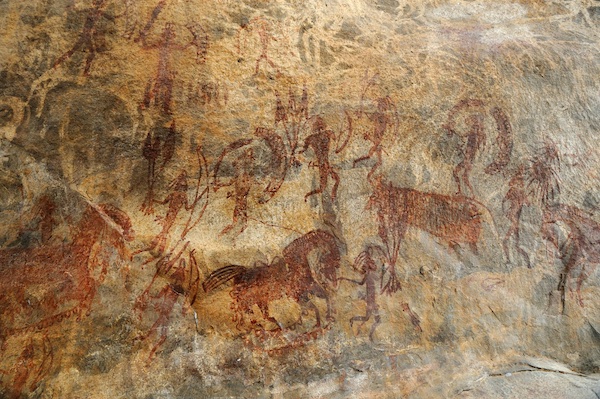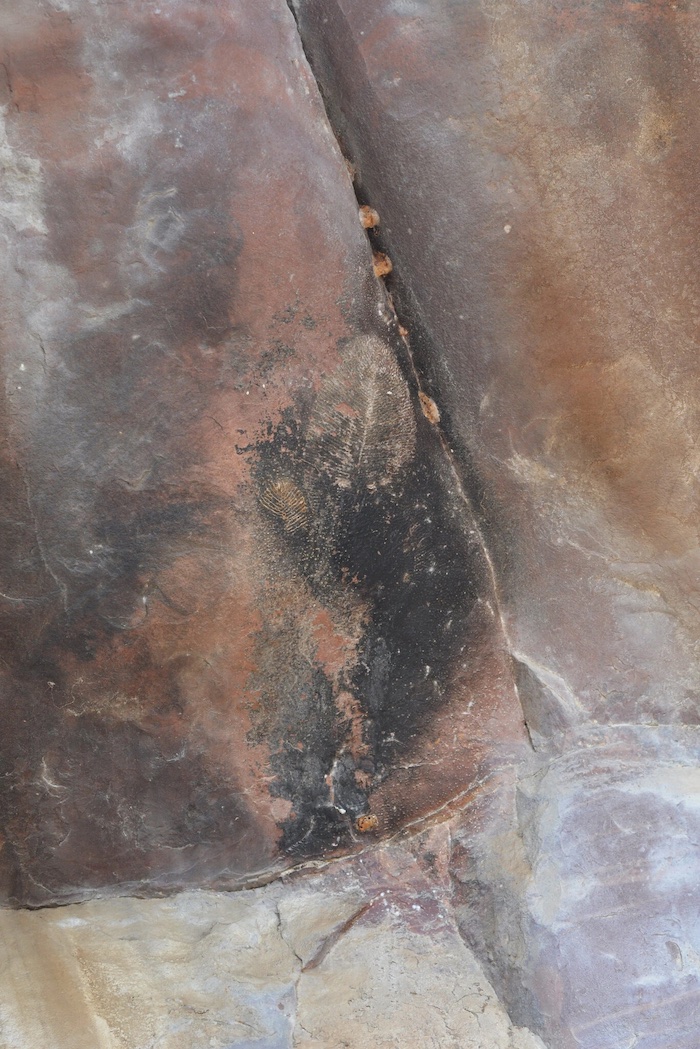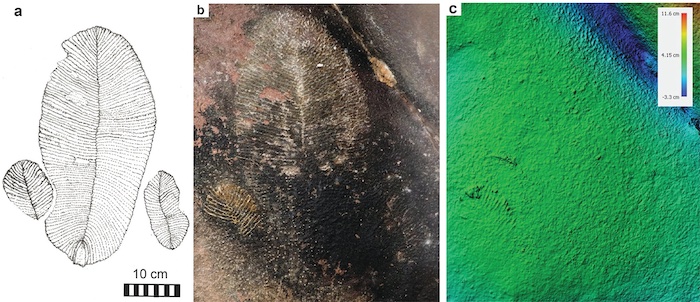Bhimbetka: Dickinsonia
This is a collection of articles archived for the excellence of their content. |
India’s lone fossil of world’s oldest animal
Jamal Ayub, February 10, 2021: The Times of India
Discovered in Bhimbetka, India’s lone fossil of world’s oldest animal
BHOPAL: Hidden in plain sight, one of the rarest fossils in the world may have been discovered in the fascinating Bhimbetka rock shelters, a Unesco site about 40km from Bhopal.
Researchers believe they have found the first-ever fossil in India of a Dickinsonia —the Earth’s ‘oldest animal’, dating back 570 million years — on the roof of what’s called the ‘Auditorium Cave’ at Bhimbetka.
The find has been published in the February edition of Gondwana Research, an international journal. Dickinsonia fossils have shown they could exceed four feet in length but the one found in Bhimbetka is 17 inches long.
Like the awe-inspiring rock shelters themselves, this fossil was discovered by chance. Two experts from Geological Survey of India (GSI) were on a sightseeing tour of Bhimbetka ahead of the 36th International Geological Congress, which was scheduled for March 2020 but was postponed twice due to the pandemic, when they spotted the leaf-like impression.
Eleven feet above the ground, almost blending with the rock and easily mistaken by laymen for prehistoric rock art, they found imprints of the Dickinsonia, believed to be one of the key links between the early, simple organisms and the explosion of life in the Cambrian Period, about 541 million years ago.
“The fossils were found in the roof of Auditorium Cave at Bhimbetka Rock Shelters, a Unesco World Heritage Site for Paleolithic and Mesolithic cave art, near Bhopal. They are identical with Dickinsonia tenuis from the Ediacara member of the Rawnsley Quartzite in South Australia,” says an abstract of the paper ‘Dickinsonia Discovered in India and Late Ediacaran Biogeography’ in Gondwana Research, posted on the web.
The writeup is attributed to Gregory J Retallack, Neffra A Matthews, Sharad Master, Ranjit G Khangar and Merajuddin Khan. “The discovery of Dickinsonia in India allows assessment of biogeographic provinces and plate tectonic reconstructions for the late Ediacaran,” it says, adding: “This new occurrence confirms assembly of Gondwanaland by 550 Ma, but not reconstructions adjusted for true polar wander. Cloudina and other small shelly marine fossils were low latitude, but vendobionts such as Dickinsonia were at temperate to subtropical latitudes.”
How did it lie undiscovered all these years? The Bhimbetka rock shelters were found by V S Wakankar 64 years ago. Since then, thousands of researchers have visited the site, but this rare fossil went undetected.
“ASI deals in geologic time scale, quaternary period, that began 2.6 million years ago and extends into the present. Anything before the beginnings of human evolution is not covered,” said retired ASI joint director general, S B Ota. “I have seen the picture on social media. It is on a deposit on sedimentary rock. A paleobotanist could determine its genesis,” he added.
A GSI team had conducted extensive work in the Vindhyan Hills some 20 years ago to meet operational guidelines of Unesco before Bhimbetka was declared a world heritage site. GSI mapped the area and since then the number of rock shelters has increased from 400 to 1000, said Ota, who is also a Tagore research fellow.
Vindhyan Hills, where these rock paintings are located is an area of massively sculpted sandstone rock formations clustered around cave-art rich Bhimbetka Hill. “Again, GSI scope was limited to quaternary,” he said.
Suddenly, time lapse has a whole new meaning at Bhimbetka. The ancient cave art is young, compared to Dickinsonia. According to Unesco, the Bhimbetka rock art is believed to date from the Mesolithic period (around 10,000 years ago), through the Chalcolithic (Microlithic) and right into the historic, medieval and recent historic periods. “Cosmogenic nuclide dating is being deployed to determine time of earliest human culture. India's oldest stone-age tools, up to 1.5 million years old, are at a prehistoric site near Chennai,” said Ota.
Does ASI have any plans for it? “We have received no request for sampling of Dickinsonia,” said ASI Bhopal superintendent, Piyush Bhatt.
NYT’s 2021 report
Joshua Sokol, February 5, 2021: The New York Times

From: Joshua Sokol, February 5, 2021: The New York Times

From: Joshua Sokol, February 5, 2021: The New York Times

From: Joshua Sokol, February 5, 2021: The New York Times
Ten thousand years ago or more, people started painting the walls of caves near Bhopal, India. Over the millenniums they made thousands of images in what are now called the Bhimbetka Rock Shelters: men, women, a couple having sex, dancers, children, hunts, battles, about 29 different animal species and mythical beasts like a part-boar part-ox part-elephant.
Over time, art styles shifted. Human figures donned clothes. Horses and elephants sprouted riders. Wars danced across sandstone faces. Today, many of the cave walls are now palimpsests, with medieval warriors covering Chalcolithic art on top of even older Mesolithic drawings.
Still, an overlooked pattern spotted by a tour group of scientists in March 2020 seemed so, so, so much older. Older than representational art or humans or primates or fish or horseshoe crabs. Eleven feet up on the wall of an area called Auditorium Cave, the visitors had identified something that looked an awful lot like an imprint of Dickinsonia, an iconic 550 million year-old fossil from the first bloom of complex life on Earth.
The gaggle of geologists had traveled to India for last spring’s International Geological Congress, which was then canceled because of the pandemic. But the pre-conference field trips went ahead, including a visit to the caves led by Ranjit Khangar and Merajuddin Khan from the Geological Survey of India. “Talk about serendipity,” said Gregory Retallack, a paleontologist at the University of Oregon who described the 17-inch fossil this month in the journal Gondwana Research. “Finding it where we would not expect, on the last day of the expedition, in a cultural stop?”
Dr. Retallack and the others didn’t have hammers or equipment on them. Instead they took as many different pictures from as many different angles as possible. Back home after the trip, they used image-based 3-D modeling software to take a closer look.
Dickinsonia, a blob with internal ridges that looks vaguely like a halved Christmas ham, has been found in Australia, Russia, Ukraine and as of this January, close to China’s Three Gorges Dam. No Indian specimens were known. But the size, shape and surrounding rocks of the Bhimbetka pattern all match Dickinsonia fossils elsewhere, the team argues, confirming the find.
Within Indian geology, the discovery may settle a long debate about the ages of ancient basins like the one that hosts the Bhimbetka site. Some studies date these rocks to 800 or 900 million years ago; others have suggested they are younger. Fossils, tied to specific ages like footnotes on the pages of a book, could help.
“People have been trying for decades to look at the fossil content of these rocks, and they haven’t come up with much convincing evidence,” said Suvrat Kher, a science writer in Pune, India. The presence of Dickinsonia, however, nails down an age of about 550 million years.
Other scientists note that Dr. Retallack is embroiled in a deep debate over where Dickinsonia and other bizarre early organisms fit on the tree of life.
Recent scientific consensus has shifted toward calling them prototypical animals that lived on the seafloor. But Dr. Retallack’s work has held that these organisms — including this one — lived on land, not in the sea, and that they were lichens.
But his critics make an exception for this finding.
“Most of Greg’s work, there’s a million reasons why it’s wrong,” said Emily Mitchell, a paleontologist at the University of Cambridge. “This, to me, it’s feasible. And if it was it would be very very cool.”
The discovery might really be Dickinsonia, she said. One way to further examine that might be to get permission to scrape off and test a little material. But given where it was found, she said, it also could be a painting or petroglyph itself, a possibility rejected in Dr. Retallack’s study.
If it is just cave art, it could merely be a satisfying, simple design that only looks like Dickinsonia to paleontologists with that fossil already on the mind. Or to add confusion: it could even be an ancient rendering of a Dickinsonia.
So maybe it’s a drawing that happens to look like a fossil, or a drawing about a fossil, or maybe it’s the real deal: a trace from the dawn of life nearly overwritten by the dawn of human creativity.
In that latter case, “I think wow, they can’t have failed to notice it,” said Dr. Retallack, speculating about the cave artists. “I wonder if that was why they decided to decorate the cave?”
See also
Bhimbetka: Dickinsonia